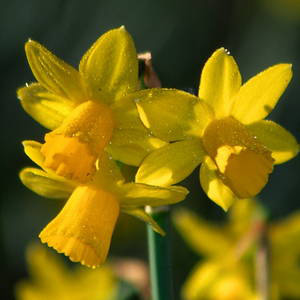Daffodil Divisions and Classifications
 Daffodils are classified using two parts of the flower. For the purpose of this description, the daffodil is divided into two regions, the perianth (petals) and corona (cup).
Daffodils are classified using two parts of the flower. For the purpose of this description, the daffodil is divided into two regions, the perianth (petals) and corona (cup).
In further classifying daffodils the perianth (petals) is described by identifying first the outside edge of the petal, then the middle, and lastly the inside part next to the corona.
The information I am providing in this article is gleaned from two sources, The American Daffodil Society and Brent and Becky’s Bulbs. Both of these websites offer untold amounts of information and make enjoying the spring displays even more rich.
The Daffodil Society even has downloadable & printable coloring books for those individuals who work with children’s groups. Brent and Becky’s information filled Fall Bulb catalog arrived just in time for Spring so that we can go out to view daffodils in other gardens and make a list for next year’s display.
All daffodils are classified into one of the thirteen divisions described below:
|
One flower to a stem, corona (trumpet or cup) as long or longer than the perianth segments (petals).Trumpets usually produce larger bulbs than other divisions. Most have gray/green foliage ½” – 1” wide |
|
|
One flower to a stem, corona (cup) more than one third but less than equal to the length of the perianth segments (petals).The group that you see the most often used in gardens; perfect for perennializing, picking, forcing and showing; some of the showiest daffodils are in this division and are the ones that give you more ‘bang for your landscape buck’. |
|
|
One flower to a stem, corona (cup) not more than one third the height of the perianth segments (petals).These are long term perennializers, show flowers and late season picked flowers, often with a spicy fragrance. |
|
|
Daffodils have a clustered cup, petals or both. There can be one or more flowers per stem.Camellia or roselike flowers; with single of multiple blooms; good for shows, showy gardens, picking and bedding. |
|
|
Usually more than one flower to a stem, head drooping, perianth segments often reflexed and of silky texture.Fuchia-like blooms often with a fruity fragrance; great in containers. |
|
|
One flower to a stem, perianth significantly reflexed and corona straight and narrow. Some exceptions exist.With their faces looking like they are standing in front of a fan, they look & perform wonderfully in pots & are terrific for forcing; seem to be more tolerant to partial shade moisture as a group. |
|
|
Usually several flower heads to a stem, flowers usually fragrant, stem is round in cross-section and foliage is often rush like.Foliage is often reed-like or at least very narrow & dark green. Most like the hot baking summer sun. Better in southern gardens but some are adaptable in cooler climates. Sweetly fragrant. Most are great in pots. |
|
|
Usually three to twenty flowers to a stout stem, sweet scented and very short cupped. Perianth segments rounded and often somewhat crinkled.Excellent perennialzers with a musky, sweet fragrance; good for Southern gardens & forcing. |
|
|
Usually one flower to a stem. White petals sometimes stained with the corona color at the base, small flat cup edged with red.Excellent perennials with a spicy fragrance, dogwood-like blooms; good for picking. |
|
|
Usually one flower to a stem. Perianth segments insignificant compared with Corona.Cultivars in this division are offspring of the species bulbocodium conspicuus, often referred to as ‘Hoop Petticoat’. |
|
|
Corona split – usually more than half its length.A division where the cup of the daffodil is split into segments & spreads back against the petals. Sometimes the cup is smooth, often it’s frilly & many other times it’s in between.11a) Collar Daffodils Split-corona daffodils with the corona segments opposite the perianth segments; the corona segments usually in two whorls of three11b) Papillon DaffodilsSplit-corona daffodils with the corona segments alternate to the perianth segments; the corona segments usually in a single whorl of sixColoration of the corona often appears in sunburst-like streaks. |
|
|
Daffodils not falling into any of the previous categories. |
|
|
Ones that are referred to as species daffodils & most of which are Heirloom & suitable for restoration gardening from 1700 on. |
All photos are from the Brent and Becky’s 2013 Fall Catalog.
Disclosure: We receive NO financial or other consideration from either of these organizations for linking to their websites.
Brent and Becky’s Bulbs.. Either read their print catalog or view their digital catalog online.
American Daffodil Society. Visit and learn from their information filled website.

 Division 1 – Trumpet
Division 1 – Trumpet Division 2 – Large Cup
Division 2 – Large Cup Division 3 – Short Cup
Division 3 – Short Cup Division 4 – Double
Division 4 – Double Division 5 – Triandrus
Division 5 – Triandrus Division 6 – Cyclamineus
Division 6 – Cyclamineus Division 7 – Jonquilla
Division 7 – Jonquilla Division 8 – Tazetta
Division 8 – Tazetta Division 9 – Poeticus
Division 9 – Poeticus Division 10 – Bulbocodium Hybrids
Division 10 – Bulbocodium Hybrids Division 11 – Split Corona
Division 11 – Split Corona Division 12 – Other Cultivars
Division 12 – Other Cultivars Division 13 – Species All species and reputedly wild forms.
Division 13 – Species All species and reputedly wild forms.